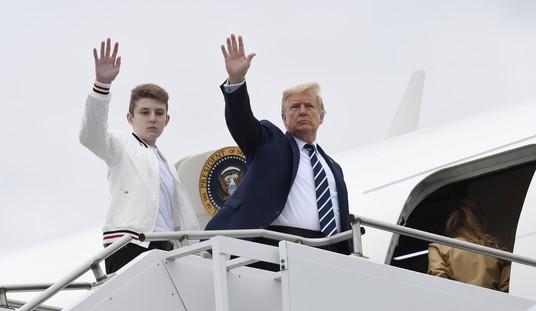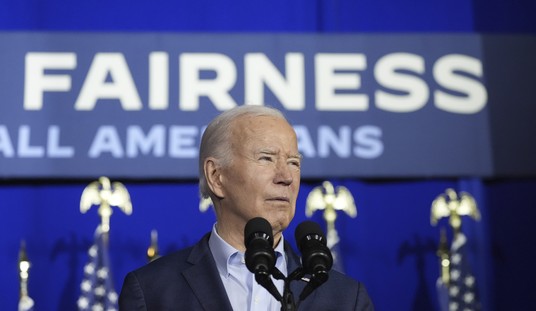Bill Roggio has a very interesting article describing the ISIS plan to invest Baghdad. They aim to infiltrate the surrounding towns until they control a “belt” around the capital. From this vantage they will gradually paralyze the capital through unremitting campaign of terror and subversion until it can be taken outright.
The encirclement won’t consist of trenches or other physical obstructions. Rather it will be comprised of clandestine networks and supply systems that will move bombs, weapons and fighters around through a network of cells and safe houses to locations in and around the city. It is, as Bill Roggio points out, a rehash of the Sunni strategy to encircle US forces during Operation Iraq Freedom.
The lightning advance of the Islamic State of Iraq and the Sham and its allies from Mosul to the outskirts of Samarra, as well as its capture of several towns in eastern Diyala, all over the course of several days, appears to be part of a greater strategy to surround the capital of Baghdad before laying siege to it. This plan, to take over the “belt” region outside of Baghdad and cut off the capital, appears to be the same strategy used by the ISIS’ predecessor back in 2006.
The 2006 plan, which was drawn up by the Islamic State of Iraq (ISI), the forerunner of the Islamic State of Iraq and the Sham (ISIS), was discovered after the US found a crude map on the body of Abu Musab al Zarqawi, al Qaeda in Iraq’s leader who was killed by US forces in Baqubah in June 2006. The “Baghdad belts” map was released by Multinational Forces-Iraq during its offensive to liberate vast areas under al Qaeda/ISI control in 2007 and 2008.Zarqawi’s plan was to seize control of the outer provinces and Baghdad’s belts, or key areas surrounding the capital. The ISI would then use its bases in the belts to control access to Baghdad and funnel money, weapons, car bombs, and fighters into the city. The ISI also planned to strangle the US helicopter air lanes by emplacing anti-aircraft cells along known routes in the belts areas around Baghdad.
Back in 2007 I co-authored an article in the Jerusalem Post with the commander of the 3rd Brigade, 101st Airborne, Colonel Dominic J. Caraccilo exploring this issue. His job then was to dismantle the southern belt, then known as the Triangle of Death.
As everyone now knows the campaign against US forces back in 2006 failed. The attackers were counter-encircled by US-led forces who established intelligence assets of their own to find and destroy the enemy. Much effort was put into tracking back weapons smuggling routes back to their sources, including explosively formed penetration IEDs whose cores were manufactured in Iran. US conventional units provided the “top cover” for the intel guys who went out to look for the enemy.
Now ISIS is playing the same number on Maliki, right down to a new Triangle of Death. Roggio continues:
Watching the ISIS’ operations today, it appears the group is attempting to implement a strategy which is very similar, if not identical, to the previous one. This should come as no surprise; Nasser al Din Allah Abu Suleiman, ISIS’ current war minister, was a leader in al Qaeda in Iraq/ISI when the Baghdad belt strategy was implemented. Suleiman was appointed by al Qaeda in May 2010 to serve as the terror group’s top military commander after his predecessor, Abu Ayyub al Masri, was killed in a raid by Iraqi and US forces in April 2010.
US intelligence officials contacted by the Long War Journal who have extensive experience with al Qaeda in Iraq and the campaign to dislodge the group that began in 2007 said they believe the ISIS has dusted off its old plans to encircle Baghdad. …
ISIS took the first step at the beginning of the year when it seized control of Fallujah and most of Anbar province. ISIS advanced to the outskirts of western Baghdad in March and April, when it captured Karma and Abu Ghraib.
After taking control of most of Anbar, ISIS launched a series of bombings and attacks in northern Babil province and southern Baghdad. The town of Jurf Al Sakhar is said to have fallen under ISIS control. The towns of Musayyib, Yusufiyah, Mahmoudiyah, Iskandariyah and Latifiyah in the so-called “triangle of death” area south of Baghdad have seen an uptick in attacks. These areas, which include a significant Sunni minority, sit along the fault line with Sunni and Shia, and were controlled by the ISI prior to the US surge.
Maliki will have to reinvent the wheel, with this difference: his forces are far less competent than the US units which preceded him. More firepower may be provided to the Iraqi government, but key factors of combat leadership and institutional knowledge have been dispersed and lost, perhaps for the duration.
Partisan criticism aside, history will show that the US Armed Forces in Iraq successfully defeated an enemy whose style of war, as idealized in the movie Battle of Algiers, is hard to defeat. The failure of the French in Algeria and current difficulties of even the Israeli Defense Forces against the terror armies show it is no easy task. While terrorists are often portrayed as semi comical “rag-tag” forces facing Western professionals, in reality operatives like Imad Mughniyah, Abu Musab al-Zarqawi, Saddam Hussein and the current leadership of ISIS are consummate pros themselves, with decades of operational, clandestine and political experience.
They know all there is to know about intrigue, intimidation and war. They are unrestrained by any scruple, law or accountability. All they understand is power; how to seize it and how to hold it; naturally they have become very good at what they do.
Only the very best can win against them. For all of its faults the US campaign in Iraq was possibly the only Western intervention to outfight a terror campaign on the ground. Just how hard that was to achieve is underscored by the current administration’s miserable failures. President Obama threw much of the machinery of victory away. The edifice of victory in Iraq consisted for the most part of a human network; of a perishable store of knowledge made up of relationships and reciprocal deals which guided policy and firepower. The “institutions” so beloved of academic papers consist in the last analysis of people who know and trust other people.
With any luck the administration will recover part of what they so contemptuously cast away. But perhaps they don’t even know what they’re missing. The Obama administration came to office describing itself as ‘nuanced’. It promised to engage in ‘smart diplomacy’. It swore to be ‘transformational’. But perhaps the administration has confused the trappings of competence with its essence, like a writer who thinks buying a beret and moving into a Paris garret will make him a Hemingway. Julie Hirschfield describes how president Obama escapes the mundane drudgery of governance in a New York Times article: “At Dinner Tables, a Restless Obama Finds an Intellectual Escape”. He dines with celebrities and public intellectuals.
“It keeps him fresh,” the article says. He needs air purged of the ordinary; unencumbered by commonplace problems to breathe and to soar to his full height. Not for him is the boring detail of fighting a war. He wants ideas and vaulting concepts.
WASHINGTON — President Obama had just disembarked from Air Force One and was still on the tarmac in Rome when he turned to his host, John R. Phillips, the American ambassador to Italy, with an unexpected request: How about a dinner party tomorrow night?
Over the next 24 hours, the startled Mr. Phillips and his wife, the former Obama aide Linda Douglass, scrambled to gather some of Italy’s intellettuali.
The architect Renzo Piano flew in from Genoa. The particle physicist Fabiola Gianotti arrived from Geneva. John Elkann, the chairman of Fiat and an owner of the Italian soccer club Juventus, came, too, as did his sister, Ginevra, a film director. Over a 2006 Brunello, grilled rib-eye and three pasta dishes — cacio e pepe, all’arrabbiata and Bolognese — at Villa Taverna, the 15th-century manor that serves as the ambassador’s residence, the group talked until close to midnight about “the importance of understanding science, the future of the universe, how sports brings people together, and many other things,” Ms. Douglass said. …
In a summer when the president is traveling across the country meeting with ordinary Americans under highly choreographed conditions, the Rome dinner shows another side of Mr. Obama. As one of an increasing number of late-night dinners in his second term, it offers a glimpse into a president who prefers intellectuals to politicians, and into the rarefied company Mr. Obama may keep after he leaves the White House.
But there may be a fatal vanity in this. The world of high flying ideas is an intoxicating one. But there is a great deal of information embedded in the world of ISIS; a world of expertise in the grubby world of engineers, mechanics and soldiers. Ordinary people are often smarter than intellectuals realize, and very often smarter than they can imagine. President Obama may think he’s smart but he still has to prove he can beat the terror armies.
Recently purchased by Belmont Club visitors:
A Canticle for Leibowitz
Japanese Destroyer Captain
Operation Drumbeat: Germany’s U-Boat Attacks Along the American Coast in World War II
Recommended:
simplehuman Compact Sensor Pump with Soap Sample
Acer C720 Chromebook (11.6-Inch, 2GB)
God Less America: Real Stories From the Front Lines of the Attack on Traditional Values
Devil at My Heels
Did you know that you can purchase some of these books and pamphlets by Richard Fernandez and share them with you friends? They will receive a link in their email and it will automatically give them access to a Kindle reader on their smartphone, computer or even as a web-readable document.
The War of the Words for $3.99, Understanding the crisis of the early 21st century in terms of information corruption in the financial, security and political spheres
Rebranding Christianity for $3.99, or why the truth shall make you free
The Three Conjectures at Amazon Kindle for $1.99, reflections on terrorism and the nuclear age
Storming the Castle at Amazon Kindle for $3.99, why government should get small
No Way In at Amazon Kindle $8.95, print $9.99. Fiction. A flight into peril, flashbacks to underground action.
Storm Over the South China Sea $0.99, how China is restarting history in the Pacific
Tip Jar or Subscribe or Unsubscribe to the Belmont Club









Join the conversation as a VIP Member